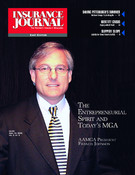While Massachusetts insurance officials are weighing a request by the industry to inch up workers’ compensation rates by 1 percent, a new study suggests that claim costs are accelerating by leaps and bounds, largely because of medical cost inflation.
The study by the Workers Compensation Research Institute found that workers’ compensation costs per claim grew an average of 10 percent per year from 2000 to 2002, showing acceleration over the three earlier years in the study period when the growth rate averaged 5.5 percent per year.
The major cost drivers in the most recent year were continuing double-digit growth in medical costs per claim and very rapid growth in benefit delivery expenses per claim.
Growth in indemnity payments per claim with more than seven days of lost time appeared to have moderated in the latest year (5 percent), after double-digit growth in the prior year.
The very rapid growth in benefit delivery expenses per claim was driven by a rapid rise in medical cost containment expenses per claim and increases in litigation expenses per claim in the latest year.
WCRI looked at 12 states: California, Connecticut, Florida, Illinois, Indiana, Louisiana, Massachusetts, North Carolina, Pennsylvania, Tennessee, Texas and Wisconsin. These states represent more than half of the nation’s workers’ compensation benefit payments.
The study also reported that average costs per claim in Massachusetts were typical compared with other states, reflecting the offsetting effects of medical payments per claim that were the lowest among the 12 study states and the fact that Massachusetts had the highest percentage of claims with more than seven days of lost time.
“The continued increase in Massachusetts workers’ compensation costs per claim bears watching, especially medical costs,” said Dr. Richard Victor, executive director of WCRI.
Meanwhile, the Division of Insurance began hearings into the latest industry rate proposal. The Workers’ Compensation Rating Bureau has filed for a 1 percent hike, a figure which is too big in the view of the state attorney general’s office.
“In fact, indications are that rates should go down,” Peter Leight, head of the AG’s insurance unit, told Commissioner Julianne Bowler. He maintained that insurers’ rate requests are “typically higher than their rate needs.” Over the last 10 years, workers compensation insurance rate requests have been more than 10 percent higher than necessary, he said.
Leight criticized the WCRB filing in three areas. He alleged that the requested profit is too high; claims frequency has been declining significantly and will likely continue to drop; and the filing exaggerates industry expenses.
“Rates need to go down,” concluded Leight, whose office is expected to file its own specific rate recommendation next month. The State Rating Bureau is also expected make a recommendation next month.
But insurance carriers and agents cautioned against reducing rates in light of claims severity trends, high reinsurance costs and market conditions. Even if the 1 percent is approved, rates would be less than half of what they were 15 years ago, they noted.
As proof of the need for a rate hike, insurers pointed to a shrinking voluntary market. The residual market now accounts for more than 40 percent of all the policies and nearly 20 percent of the premiums, testified Boston attorney Scott P. Lewis, for the WCRB.
“The Massachusetts residual market is, once again, one of the largest in the country, and it is one of the biggest providers of workers’ compensation coverage in the Commonwealth. This is not a sign of a healthy, competitive marketplace,” Lewis added.
Acknowledging that claim frequency has been going down, the industry claimed this trend is being offset by greater claim severity as both wages and medical expenses continue to rise.
Insurers also face rising reinsurance prices. This year, WCRB has included a provision in its rates for the costs of reinsurance.
Lewis urged Bowler to consider the benefit of maintaining a competitive marketplace. He warned that disapproval of the 1 percent — “or even worse, a mandated rate decrease — would, in contrast, inevitably reduce competitive activity and provide added stimulus to the already troubling growth in the residual market.”
Independent agents joined those stressing the need to keep markets open. Daniel J. Foley, Jr., vice president of government affairs, Massachusetts Association of Insurance Agents, said agents are reporting market restrictions.
“Our members have advised us that the market options available to them for their clients are dwindling. Additionally, they are finding more and more of their clients are forced to seek coverage through the workers’ compensation assigned risk pool.”
Foley added that clients insured through the involuntary market’s assigned risk pool are deprived of rate deviations, dividends and premium discounts available in the voluntary market.
Was this article valuable?
Here are more articles you may enjoy.


 Travelers Reverses Q2 Income Loss, Narrows Underwriting Loss
Travelers Reverses Q2 Income Loss, Narrows Underwriting Loss  Wall Street Pushes Back After Activists Escalate Protests
Wall Street Pushes Back After Activists Escalate Protests  Beryl’s Remnants Spawned 4 Indiana Tornadoes, Including an EF-3: NWS
Beryl’s Remnants Spawned 4 Indiana Tornadoes, Including an EF-3: NWS  Hacker Says AT&T Paid About $400,000 to Erase Sensitive Data
Hacker Says AT&T Paid About $400,000 to Erase Sensitive Data 


